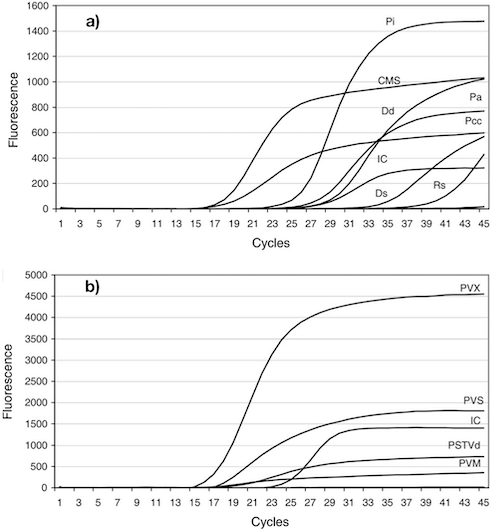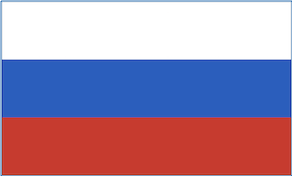- The method employs two-dimensional open-type matrices each node (microreactor) of which (30 or 48) contains stabilised PCR mixture necessary to determine specific object (transformation event, genetic element, specific nucleotide sequence…). The mixtures include primers, probes, hot start taq-polymerase, reverse transcriptase (in case of detection and identification of viral pathogens) and dNTPs required for real-time PCR and preliminary reverse transcription (for viruses and viroids);
- test-systems are used to perform one stage detection and identification of plant pathogens with polymerase chain reaction in real time mode in matrix format;
- 53 test systems include primers, probes and plasmids (positive control) for identification of phytopathogens viral, bacterial, oomycetal, fungal origin, as well as phytoplasma and nematodes; test-systems can be configured on the matrics in a free way to fit end user's needs;
- Special technology of immobilization and stabilization of PCR mixtures on the surface of microreactors ensures long shelf life of matrices for up to 6 months (3 months for viruses and viroids) at room temperature with no special conditions, and reduces the number of necessary manipulations (it is only necessary to apply DNA/RNA sample on the matrix). The analysis can be performed in both stationary and field laboratories. small volume of reaction (1.2 μl) reduces consumption of reagents and total duration of the assay to 1.5-2 hours, including DNA/RNA extraction stage;
- test systems have been checked with reference smples and/or reference genetic material (DNA/RNA) of phytopathogens, as well as with field samples obtained from the State collection of phytopathogenic microorganisms, All-Russian Institute of phytopathology, All-Russian Institute of plant quarantine, A.G.Lorkh All-Russian Institute of potato farming, the Russian Agricultural Center the Russian Argicultural Center, Agdia Biofords (France), Leibniz-Institut DSMZ - Deutsche Sammlung von Mikroorganismen und Zellkulturen GmbH (Germany), Loewe Biochemica GmbH (Germany); testing results were checked in parallel by ELISA and traditional microbiological methods;
- main results of the method application are published in major pier-reviewed scientific journals.
Viruses / viroids
| Pathogen | Common name | Crops mainly affected |
|---|---|---|
| PVA | Potato virus А | Potato |
| PLRV | Potato leaf roll virus | Potato, tomato |
| PVM | Potato virus М | Potato |
| PMTV | Potato mop-top virus | Potato, other species of <i>Solanaceae</i> family, <i>Chenopodiaceae</i> |
| PVS | Potato virus S | Potato |
| PVX | Potato virus X | Potato, tomato, tobacco, pepper (<i>Capsicum</i> sp.), amaranth, artichoke, clover... |
| PVY<sup>O</sup> | Potato virus Y (ordinary form) | Potato, tomato, tobacco, pepper |
| PVY<sup>NTN</sup> | Potato virus Y (necrotic form) | Potato, tomato, tobacco, pepper |
| PVY | Potato virus Y (all forms) | Potato, tomato, tobacco, pepper |
| CMV | Cucumber mosaic virus | Over 1200 species from more than 100 families including all<i>Cucurbitae</i>, tomato, pepper, lettuce, spinach, celery… |
| PepMV | Pepino mosaic virus | Pepino, tomato |
| TAV | Tomato aspermy virus | Tomato, tobacco, beans, quinoa, chrysanthemum… |
| TMV | Tobacco mosaic virus | Tobacco, tomato and other <i>Solanum</i> species |
| ToMV | Tomato mosaic virus | Tomato, potato |
| TSWV | Tomato spotted wilt virus | Over 1000 species from more that 85 families, including tomato, tobacco, pea nut |
| TYLCV | Tomato yellow leaf curl virus | Tomato and other <i>Solanum</i> species, beans, petunia |
| TRV | Tobacco rattle virus | Over 400 species from more than 50 genera, including <i>Solanum</i>… |
| PSTvD | Potato spindle tuber viroid | Potato, tomato and other <i>Solanum</i> species |
| PRSV-P | Papaya ringspot virus, type P | Papaya, <i>Cucurbitaceae</i> (watermelon, melon, squash, cucumber) |
| PRSV-W | Watermelon mosaic virus | <i>Cucurbitaceae</i> (watermelon, melon, squash, cucumber) |
| SMV | Soybean mosaic virus | <i>Fabaceae</i> (soybean, bean, pea, cowpea and other.), <i>Cucurbitaceae</i>, <i>Amaranthaceae</i>, <i>Caricaceae</i>, <i>Passifloraceae</i> |
| BCMV | Bean common mosaic virus | <i>Fabaceae</i> (bean, soybean, cowpea, peanut, lupine) |
| BYMV | Bean yellow mosaic virus | <i>Fabaceae</i> (soybean, bean, pea, peanut, lupine, alfalfa), clover, poppy, gladiolus |
| SVNV | Soybean vein necrosis virus | Soybean |
| AMV | Alfalfa mosaic virus | <i>Fabaceae</i> (soybean, alfalfa, cowpea, bean, pea…), <i>Cucurbitaceae</i>, <i>Solanaceae</i> (potato, tomato, tobacco, bellpepper), lettuce, clover… Over 600 species from more than 70 families |
Bacteria / oomycets
| Pathogen | Common name | Crops mainly affected |
|---|---|---|
| <i>Clavibacter michiganensis</i> subsp. <i>sepedonicus</i> (CMS) | Potato ring rot | Potato, tomato eggplant |
| <i>Dickeya dianthicola | Potato black leg (soft rot) | Potatoes, tomato, artichoke, chicory, fainbow pink, dahlias, iris, kalanchoe... |
| <i>Dickeya solani</i> | Potato black leg (soft rot) | Potato),<i> Cyperus rotundus</i> (wild host), tomato, hyacinth, iris |
| <i>Pectobacterium atrosepticum</i> | Potato black leg (soft rot) | Potato |
| <i>Pectobacterium carotovorum</i> subsp. <i>brasiliensis</i> | Potato black leg (soft rot) | Potato, carrots, pepper |
| <i>Pectobacterium carotovorum</i> subsp. <i>carotovorum</i> | Potato black leg (soft rot) | Potato |
| <i>Pectobacterium wasabiae | Potato black leg (soft rot) | Potato, sweet pepper, wasabi (Japanese horseradish) |
| <i>Ralstonia solanacearum</i> | Bacterial wilt (brown rot) of potato | Over 200 plant species from more than 50 families |
| <i>Phytophthora infestans</i> | Late blight | Over 80 plant species |
Fungi
| Pathogen | Common name | Crops mainly affected |
|---|---|---|
| <i>Alternaria alternata</i> | Early blight | Potato, tomato |
| <i>Alternaria solani</i> | Brown spot and Black pit | Potato, tomato |
| <i>Colletotrichum coccodes</i> | Black dot, anthracnose | Over 100 species belonging to <i>Solanaceae</i>, <i>Cucurbitaceae</i>, <i>Leguminosae</i> and other families |
| <i>Fusarium </i>sp. (<i>F. avenaceum, F. culmorum, F. gibbosum, F. heterosporum, F. solani, F. sambucinum, F. oxysporum, F. sporotrichioides, F. sacchari, F. javanicum</i>) | Fusarium dry rot, Fusarium wilt | Wild range of species belonging to <i>Gramíneae</i>, <i>Solanaceae</i>, <i>Cucurbitaceae</i> and other families |
| <i>Rhizoctonia solani</i> | Rhizoctonia, black scurf | Potato, tomato, eggplant, pepper, tobacco, rice, wheat, rye, beetroot, alfalfa, cucumber, pumpkin, zucchini, squash, pattypan squash, turnip, rutabaga, rapeseed, radish, flax ... over 230 species from 66 families |
| <i>Spongospora subterranea</i> | Powdery scab | Potato, tomato |
| <i>Synchytrium endobioticum</i> | Potato wart, black scab | Potato and other species from <i>Solanaceae</i> family, including tomato and physalis |
Phytoplasma
| Pathogen | Common name | Crops mainly affected |
|---|---|---|
| 16SrI <i>Candidatus Phytoplasma asteris</i> | Aster yellows disease | Wide range of hosts |
| 16SrIII <i>Candidatus Phytoplasma pruni</i> | Peach X-Disease | Wide range of hosts |
| 16SrVI <i>Candidatus Phytoplasma trifolii</i> | Clover proliferation, stolbur | Wide range of hosts |
Nematodes
| Pathogen | Common name | Crops mainly affected |
|---|---|---|
| <i>Ditylenchus destructor</i> | Tuber-rot eelworm (wet rot, dry rot) | Polyfag. Affects over 90 plant species |
| <i>Ditylenchus dipsaci</i> | Stem and bulb eelworm | Polyfag. Affects over 500 plant species |
| <i>Ditylenchus weischeri</i> | Stem and bulb eelworm | Polyfag |
| <i>Globodera rostochiensis</i> | Golden nematode, golden eelworm or yellow potato cyst nematode | Potato, tomato, eggplant |
| <i>Globodera pallida</i> | Gale potato cyst nematode | Potato, tomato, eggplant |
| <i>Meloidogyne hapla</i> | Root knot nematode | Polyfag. Affects several hundred plant species including fruit trees, vegetables (except for cucumber), grasses |
| <i>Meloidogyne chitwoodi</i> | Columbia root knot nematode | Polyfag. Affects several hundred plant species including fruit trees, vegetables), grasses |
| <i>Meloidogyne fallax</i> | False Columbia root knot nematode | Polyfag. Affects several hundred plant species including fruit trees, vegetables), grasses |
| <i>Meloidogyne enterolobii</i> | Pacara earpod tree root-knot nematode | Polyfag. Affects several hundred plant species including fruit trees, vegetables), grasses |
Example of single-step simultaneous (in one sample) detection and identification of multiple pathogens with the use of PCR matrices "Potato pathogens: DNA" and "Potato pathogens: RNA"

DNA/RNA concentration - 1ng/ml
a) CMS - Clavibacter michiganensis subsp. sepedonicus; Pi - Phytophthora infestans; Pa - Pectobacterium atrosepticum; Pcc - Pectobacterium carotovorum subsp. carotovorum; Ds - Dickeya solani; Dd - Dickeya dianthicola; Rs - Ralstonia solanacearum; IC - internal control sample
b) PVM - potato virus M; PVS - potato virus S; PVX - potato virus X; PSTVd - potato spindle tuber viroid; IC - internal control sample
 GenBit
GenBit
